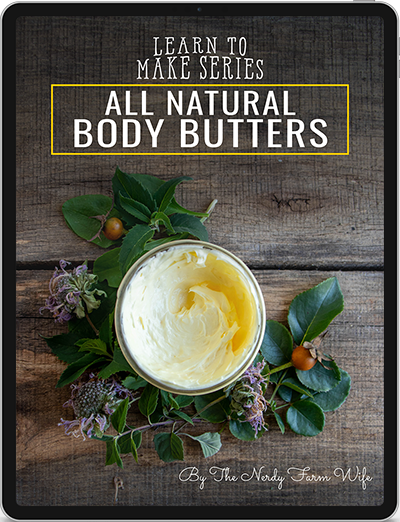8 Things to Make with Lilacs (+printable!)
Here are eight ways to use lilac flowers, plus a free printable reference sheet about growing and using lilacs.
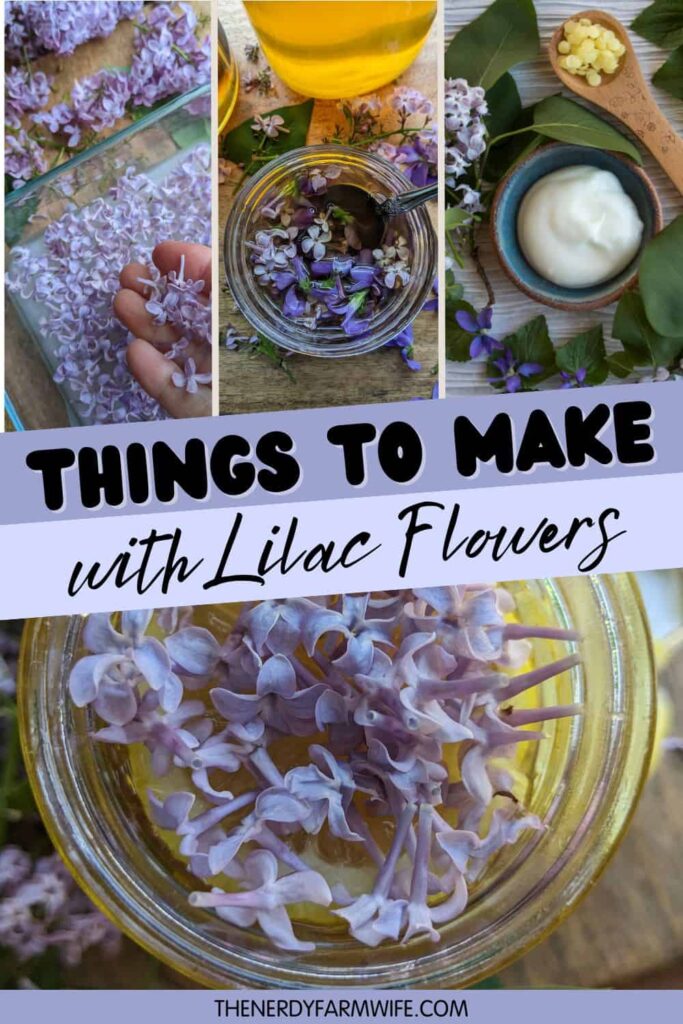
The common lilac that so many of us know and love can be used to make all sorts of wonderful natural remedies and skincare projects!
Not just a pretty springtime flower, lilacs (Syringa vulgaris) are also a good source of active compounds that act as antioxidants and help fight inflammation.
World-wide, they’ve been used in times past for things such as colds, cough, rheumatism, skin wounds, and more.
I’ve assembled some of my favorite lilac flower recipes and ideas right here, plus made a free printable lilac “cheat sheet” below that you can print out and save for easy reference!
I hope you enjoy the ideas and don’t forget to scroll down and grab your free printable!
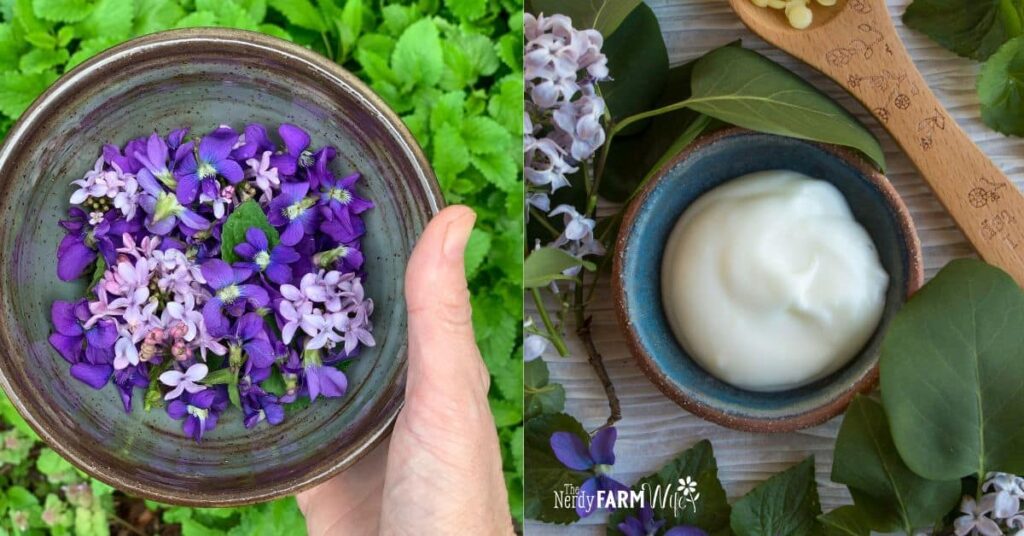
1. Lilacs & Violets in Face Cream
I made the original version of this cream for my mom’s mother’s day present one year. She loved it!
Over the years, I made a couple more variations, so you’ll find 3 versions of this recipe in my article:
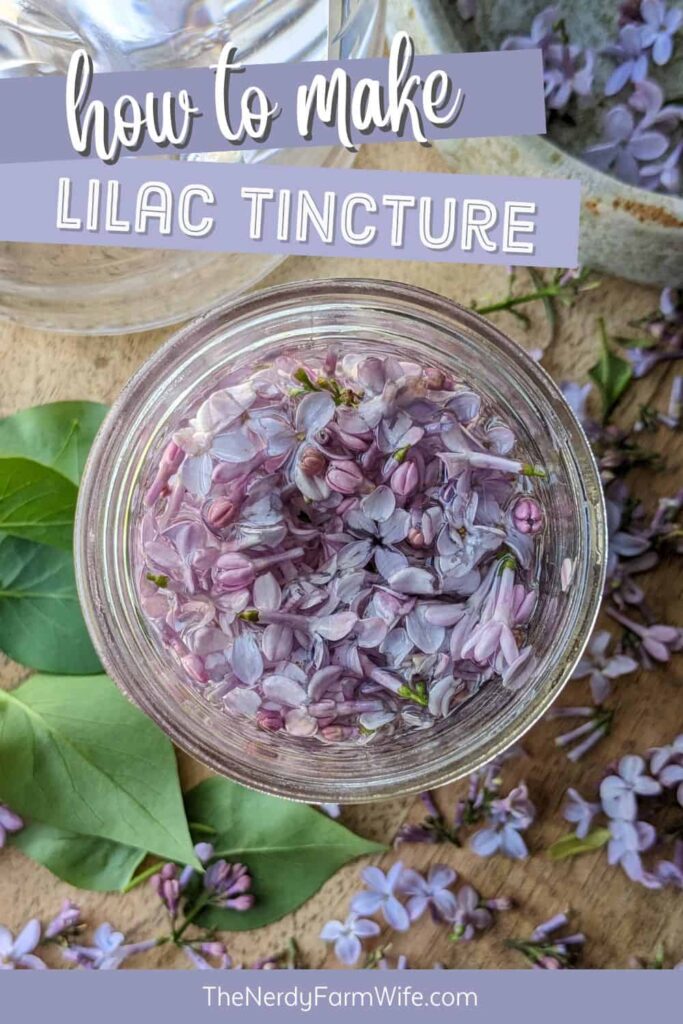
2. Lilac Tincture
This tincture is ultra easy to make! You’ll need: fresh lilac flowers, vegetable glycerin, and 100 proof vodka.
The reason you need to include glycerin is because some of fresh lilac’s beneficial compounds aren’t soluble in water or alcohol, but can be drawn out with vegetable glycerin. Glycerin also helps stabilize some tinctures.
You can buy organic palm-free vegetable glycerin from Mountain Rose Herbs. (<- I’m an affiliate for MRH, but have also been a happy customer of theirs for almost 2 decades!) :)

To make the tincture:
- Gather fresh lilac flowers and remove the stems, leaves, and any brown/wilted blooms.
- Lightly pack the flowers into a jar. I use rather small jars, or half-pints, for most tinctures, because they’re dosed in such small amounts, so you really don’t need to make huge amounts for personal/family use.
- Once the jar is filled with flowers, pour vegetable glycerin in, until the jar is about 1/8 to 1/4 full.
- Fill the rest of the jar with 100 proof vodka. Stir and top off with more vodka if needed.
- Label and place a lid on the jar, then tuck away to infuse for about 4 weeks, shaking occasionally, as you remember to.
Strain the finished tincture and store in labeled jars/bottles out of sunlight and heat. Shelf life is 1+ years. Lilac tincture can be used in homemade herbal throat sprays, or a few drops can be added to a spoonful of honey or a beverage for sore throats and mild coughs.
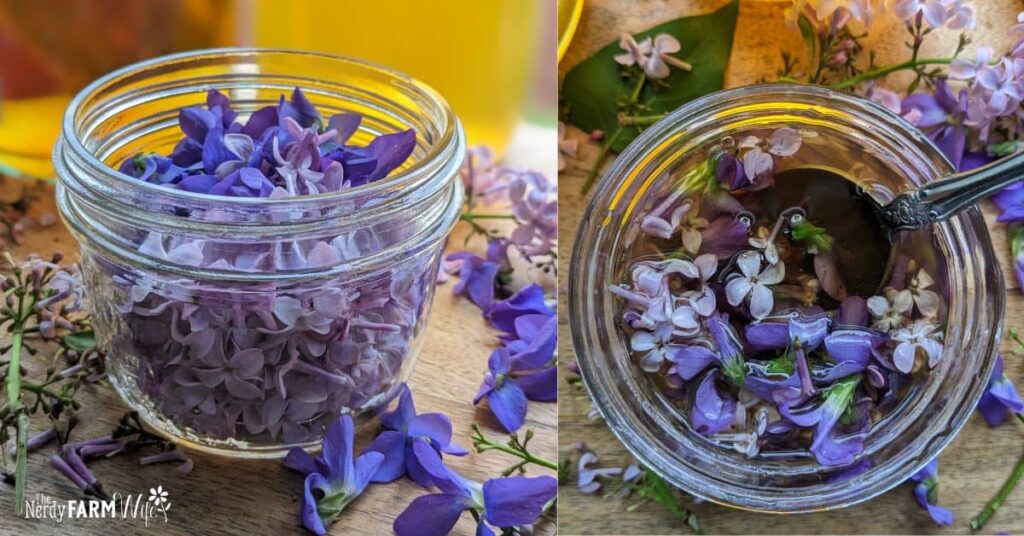
3. Sore Throat Elixir
This recipe combines fresh lilacs and violet flowers with honey and brandy. The result is a tasty elixir for sore, inflamed throats and pesky coughs.
If you don’t have brandy on hand, you can use 80 or 100 proof vodka instead. Just like the tincture recipe above, I also add a little vegetable glycerin to the mix, but if you don’t have any in your cabinets, it can be omitted from this recipe.
The full directions to make can be found at:
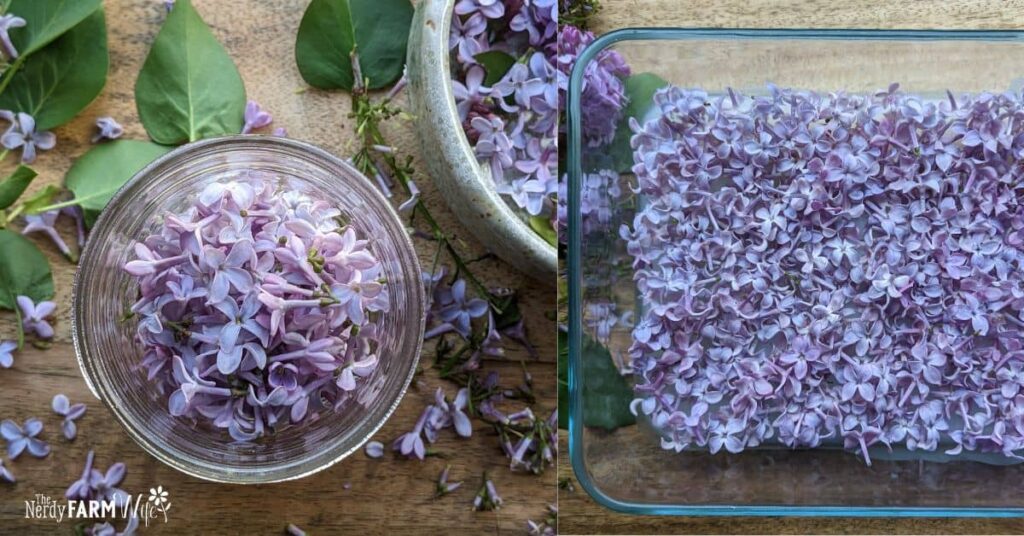
4. Lilac Enfleurage
It’s downright difficult to capture the scent of fresh lilacs. While you’ll sometimes see cheap “lilac essential oils” for sale on places like Amazon, they’re actually fragrance oils. (Unfortunately, there’s a lot of mislabeling and zero regulation about these things, and many of my readers have been duped by unscrupulous sellers of fake essential oils.)
One way that does work to softly capture the scent of fresh lilacs is enfleurage, a historical, and rather time-consuming labor of love. If you have a lot of lilacs and several weeks to invest in capturing the scent, you may want to try your hand at making your own!
Directions to do that are here:
How to Enfleurage Fresh Lilac Flowers
Or if you don’t have enough lilacs, or time to make your own, you can buy high quality authentic enfleurage from a small number of artisans, such as Cherry Valley Lilacs. (<- That’s an affiliate link, some ad blockers will block it. If yours does that, just go to Etsy and search for “lilac pomade” and look for their name, or the shop name, EnfleurageLilac.)
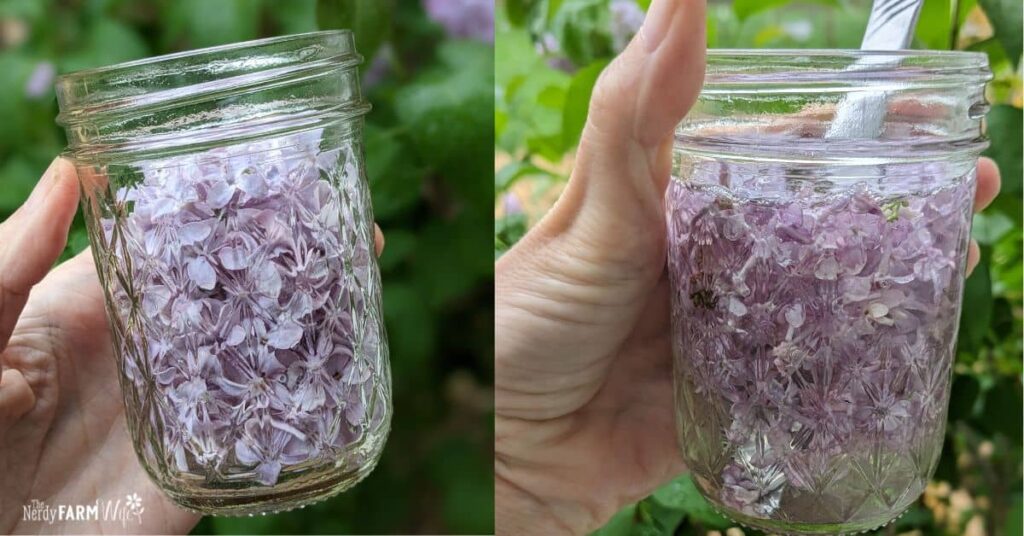
5. Lilac Face Toner
A few decades ago, I inherited an old book from the late 1800’s from my Great Grandma in which it mentioned lilacs for clearer skin. I was intrigued!
More recently, I learned that modern science has backed up the antioxidant, anti-inflammatory, and wound-healing properties connected with its traditional uses, making lilac a good addition to DIY skincare.
Besides lilac flowers, this toner features:
- Vegetable Glycerin – a humectant (attracts moisture to hydrate the surface of your skin) and is also a solvent for some of lilac’s beneficial compounds.
- Aloe Vera Gel – very soothing for irritated, red skin. If you’re allergic to aloe, just leave it out.
- Witch Hazel – an anti-inflammatory and astringent that’s useful for soothing redness, minimizing pore size appearance, and toning your skin.
To make, fill a half-pint jar about 3/4 full with fresh lilac flowers. Add 2 tablespoons of vegetable glycerin then stir well. Next, add 1 tablespoon of aloe vera (or omit this ingredient, if allergic). Now, add witch hazel to the jar until it’s almost filled. Stir and top off with more witch hazel if needed.
Label, cover with a lid, and let infuse for about 1 week. The mixture should be a pale yellow or tan color. It won’t smell like lilacs, but should smell pleasantly like witch hazel.
Strain and apply to your face as a toner or facial spritz. It’s useful for almost all skin types, but especially if you have redness, irritation, or breakouts.
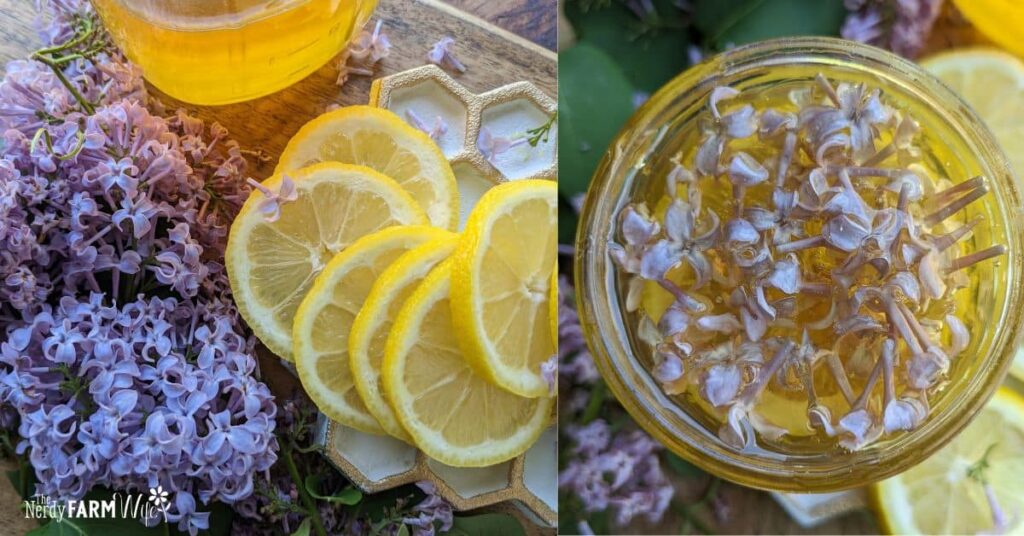
6. Lilac & Lemon Infused Honey
This combination is so delicious, it’s tempting to drink it right from the jar! :)
The inspiration for this recipe was my Ginger Lemon Honey Tonic for Colds & Flu. I wondered… what would happen if I swapped lilac flowers out for the ginger?
Well, the answer was – complete yumminess happened!
You can enjoy this lilac honey tonic syrup by the spoonful for sore throats, mild coughs, or you can stir it into tea, try it on buttered biscuits, or drizzle it over desserts.
The full recipe is right here:
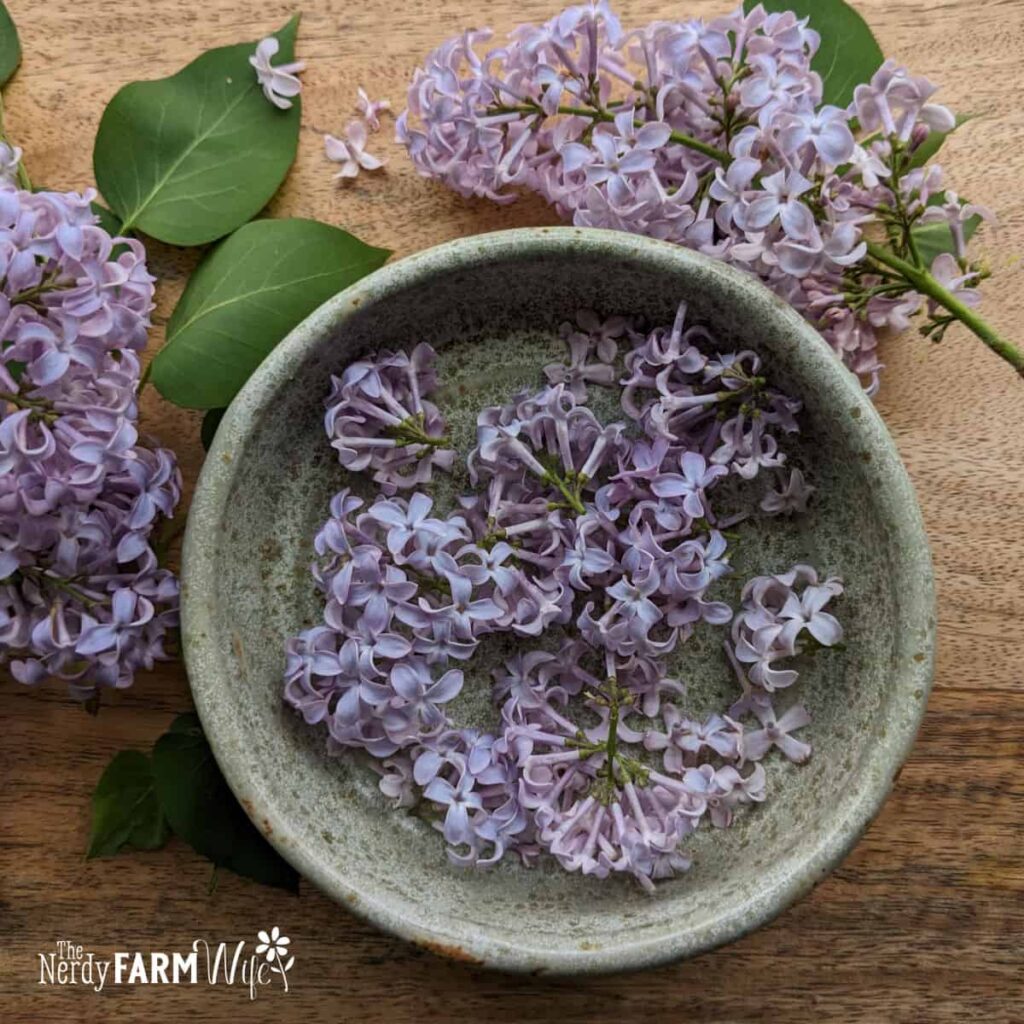
7. Lilac Sugar
This is a super simple and fun project!
The most important things to remember are: don’t use wet or damp lilacs, and don’t leave the lilac flowers in the sugar for more than half a day at a time. They must be switched out frequently, so you don’t capture the unpleasant odor of composting lilacs!
To make lilac-infused sugar:
- Place a layer of regular cane sugar in the bottom of a smallish to medium glass bowl or container, ideally more shallow than tall.
- Next, sprinkle on a layer of fresh lilac flowers. Be sure the flowers are completely dry (I don’t wash mine), don’t have any stems or twigs on them, and discard any that have brown spots on the petals. You want the freshest, most pristine flowers here!
- Sprinkle another layer of sugar to cover the lilac flowers, then if you’d like – more layers of lilacs, sugar, lilacs…. until your bowl is close to being filled.
- Cover with a lid and let the lilacs infuse into the sugar for about 10 to 14 hours, or half a day.
- Then, you’re going to sift out the sugar, compost the spent flowers, and do the whole thing over with another batch of fresh flowers.
- Repeat this process, switching out new flowers for the old at least twice a day, for just a couple of days, or until you’re happy with the scent of the sugar.

Be sure not to leave the lilacs in the sugar too long (ideally no more than half a day at a time) before swapping them for fresh flowers, or you risk them molding or spoiling, and they’ll ruin your sugar.
I find the easiest timing for me is to replace the lilacs first thing in morning as soon as the dew is dried, then again in the evening before dark. So, it’s split roughly by the half days.
Use the finished sugar in scrub recipes (or you can sprinkle it on food items), but take care with recipes that require heat, since the lilac essence is delicate!
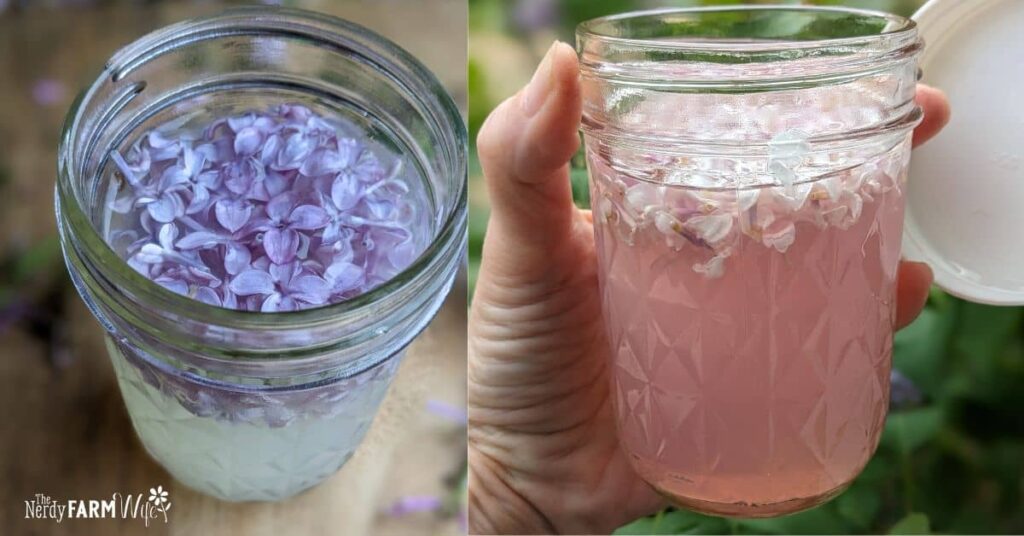
8. Lazy Lilac Lemonade
My daughter and I love making lemonade with different edible flowers. A couple we’ve shared in the past (over at my family’s Unruly Gardening site) include Redbud Lemonade and Peach Flower Lemonade.
So of course, we wanted to try making lilac lemonade too! The problem was, we already had a whole jug of store-bought lemonade in the fridge when the urge struck, and we didn’t want to make a whole second batch.
I decided to try putting a handful of fresh lilac flowers (without stems and green parts) into a jar, covering with our already-made lemonade, and letting it sit in the fridge overnight.
It worked! That method made a really tasty and pretty-colored lilac lemonade with almost zero effort on my part. (Hence why I added “lazy” to the name.) :) Just strain the lilac flowers out after they infuse overnight, so you’re not drinking smooshy, faded flowers.
Free Lilac Plant Printable
Here’s a printable “cheat sheet” about growing and using lilacs that you can save or print out for future reference.
Just click on the thumbnail of the printable above and it will open up a PDF in a new tab. If you run into problems getting it to open, write us via my contact form and we’re happy to try sending it via email instead!
Feel free to share with friends and family! :)

References & Further Reading
Dudek, M.K., et al. Hydroxycinnamoyl derivatives and secoiridoid glycoside derivatives from Syringa vulgaris flowers and their effects on the pro-inflammatory responses of human neutrophils. Fitoterapia. Volume 121, September 2017, Pages 194-205.
Marchev, Andrey S. and Milen I. Georgiev. Plant In Vitro Systems as a Sustainable Source of Active Ingredients for Cosmeceutical Application. Molecules. 2020 May; 25(9): 2006. Published online 2020 Apr 25
Oku, Hisae, et al. Effect of polyphenols from Syringa vulgaris on blood stasis syndrome. Journal of Clinical Biochemistry & Nutrition. 2020 Jul;67(1):84-88. doi: 10.3164/jcbn.20-55. Epub 2020 Jun 9.
Tóth, Gergő, et al. Characterization of antioxidant phenolics in Syringa vulgaris L. flowers and fruits by HPLC-DAD-ESI-MS. Biomedical Chromatography. 2016 Jun;30(6):923-32. doi: 10.1002/bmc.3630. Epub 2015 Nov 17.
Woźniak, Marta, et al. Effects of Phytochemically Characterized Extracts From Syringa vulgaris and Isolated Secoiridoids on Mediators of Inflammation in a Human Neutrophil Model. Frontiers in Pharmacology. 2018; 9: 349. Published online 2018 Apr 11.

